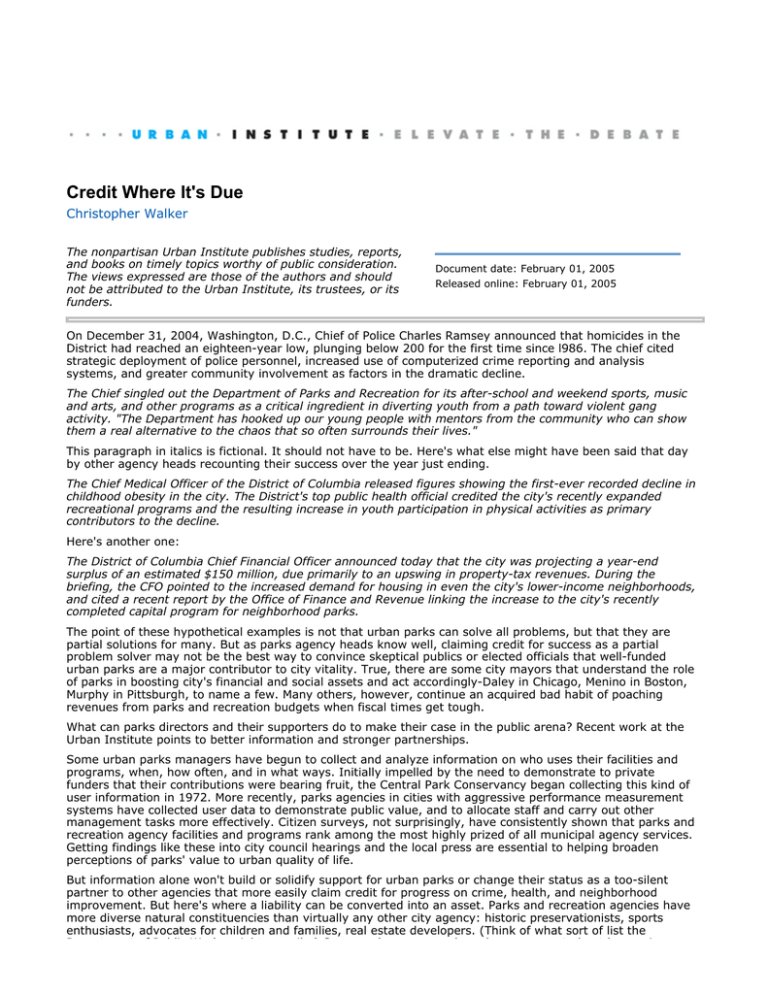Credit Where It's Due Christopher Walker
advertisement

Credit Where It's Due Christopher Walker The nonpartisan Urban Institute publishes studies, reports, and books on timely topics worthy of public consideration. The views expressed are those of the authors and should not be attributed to the Urban Institute, its trustees, or its funders. Document date: February 01, 2005 Released online: February 01, 2005 On December 31, 2004, Washington, D.C., Chief of Police Charles Ramsey announced that homicides in the District had reached an eighteen-year low, plunging below 200 for the first time since l986. The chief cited strategic deployment of police personnel, increased use of computerized crime reporting and analysis systems, and greater community involvement as factors in the dramatic decline. The Chief singled out the Department of Parks and Recreation for its after-school and weekend sports, music and arts, and other programs as a critical ingredient in diverting youth from a path toward violent gang activity. "The Department has hooked up our young people with mentors from the community who can show them a real alternative to the chaos that so often surrounds their lives." This paragraph in italics is fictional. It should not have to be. Here's what else might have been said that day by other agency heads recounting their success over the year just ending. The Chief Medical Officer of the District of Columbia released figures showing the first-ever recorded decline in childhood obesity in the city. The District's top public health official credited the city's recently expanded recreational programs and the resulting increase in youth participation in physical activities as primary contributors to the decline. Here's another one: The District of Columbia Chief Financial Officer announced today that the city was projecting a year-end surplus of an estimated $150 million, due primarily to an upswing in property-tax revenues. During the briefing, the CFO pointed to the increased demand for housing in even the city's lower-income neighborhoods, and cited a recent report by the Office of Finance and Revenue linking the increase to the city's recently completed capital program for neighborhood parks. The point of these hypothetical examples is not that urban parks can solve all problems, but that they are partial solutions for many. But as parks agency heads know well, claiming credit for success as a partial problem solver may not be the best way to convince skeptical publics or elected officials that well-funded urban parks are a major contributor to city vitality. True, there are some city mayors that understand the role of parks in boosting city's financial and social assets and act accordingly-Daley in Chicago, Menino in Boston, Murphy in Pittsburgh, to name a few. Many others, however, continue an acquired bad habit of poaching revenues from parks and recreation budgets when fiscal times get tough. What can parks directors and their supporters do to make their case in the public arena? Recent work at the Urban Institute points to better information and stronger partnerships. Some urban parks managers have begun to collect and analyze information on who uses their facilities and programs, when, how often, and in what ways. Initially impelled by the need to demonstrate to private funders that their contributions were bearing fruit, the Central Park Conservancy began collecting this kind of user information in 1972. More recently, parks agencies in cities with aggressive performance measurement systems have collected user data to demonstrate public value, and to allocate staff and carry out other management tasks more effectively. Citizen surveys, not surprisingly, have consistently shown that parks and recreation agency facilities and programs rank among the most highly prized of all municipal agency services. Getting findings like these into city council hearings and the local press are essential to helping broaden perceptions of parks' value to urban quality of life. But information alone won't build or solidify support for urban parks or change their status as a too-silent partner to other agencies that more easily claim credit for progress on crime, health, and neighborhood improvement. But here's where a liability can be converted into an asset. Parks and recreation agencies have more diverse natural constituencies than virtually any other city agency: historic preservationists, sports enthusiasts, advocates for children and families, real estate developers. (Think of what sort of list the Department of Public Works might compile.) Some parks managers have become smart about leveraging Department of Public Works might compile.) Some parks managers have become smart about leveraging these often-latent ties into concrete expressions of support, and it is no longer uncommon for parks agencies to develop and carry out joint programs with for-profit and nonprofit partners. As more agency heads get solid information into the hands of their natural allies, the day might well come when, as a matter of course, the head of parks and recreation shares the podium during the recap of the year's progress in the fight against crime; or childhood obesity; or run-down neighborhoods. Other Publications by the Authors Christopher Walker Usage and reprints: Most publications may be downloaded free of charge from the web site and may be used and copies made for research, academic, policy or other non-commercial purposes. Proper attribution is required. Posting UI research papers on other websites is permitted subject to prior approval from the Urban Institute—contact publicaffairs@urban.org. If you are unable to access or print the PDF document please contact us or call the Publications Office at (202) 261-5687. Disclaimer: The nonpartisan Urban Institute publishes studies, reports, and books on timely topics worthy of public consideration. The views expressed are those of the authors and should not be attributed to the Urban Institute, its trustees, or its funders. Copyright of the written materials contained within the Urban Institute website is owned or controlled by the Urban Institute. Source: The Urban Institute, © 2012 | http://www.urban.org

